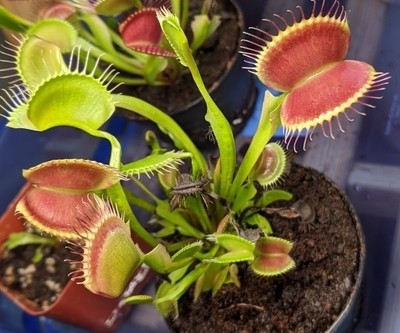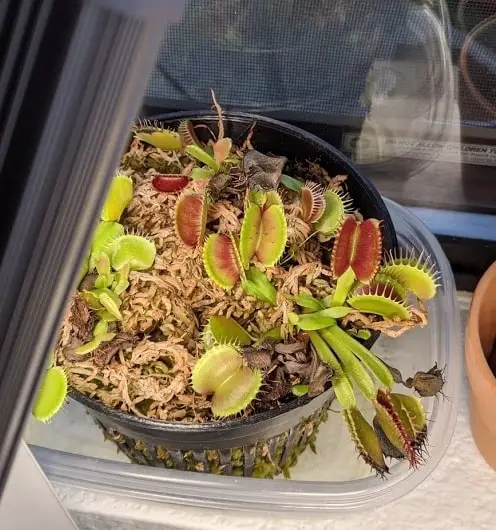Most people have heard about the predatory nature of the Venus flytrap. However, not many know about the balance of feeding Venus flytraps. Luckily, I learned starvation is not a real threat.
Venus flytraps do not starve when they are unable to capture prey. They capture insects to supplement their diet but can survive without ever having access to feed. Venus flytraps produce their own sustenance through photosynthesis.
Even though bugs are not required to keep Venus flytraps alive, feeding a Venus flytrap can benefit. In this article, I will share all the related tips to boost your plant’s health.
Can Venus Flytraps Starve?
Carnivorous plants, like the Venus flytrap, have evolved to survive in nutrient-free locations, where there is little to no access to nutrients or minerals.
Carnivorous plants grow all over the world. Each variety has developed unique predatory skills to capture insects and other arthropods.
Venus flytraps developed its bug trapping mechanism to supplement their diet. Since the plant cannot extract nutrients such as Potassium, Nitrogen, and Phosphorous from the soil, it captures and consumes bugs. The nutrients Venus flytraps extract from bugs are a supplement.
The snap trap mechanisms of the Venus flytrap capture small insects inside of their leaves. Then, the plant slowly digests them while extracting nutrients.
Venus flytraps, like other plants, produce their own food through the photosynthesis process. They can survive without access to bugs, as long as they have access to light and water.
When growing Venus flytraps, it is recommended to provide access to live insects or feed the plant manually. Also, it is critical to provide suitable lighting for the plant to avoid light starvation.
Venus flytraps can suffer from light starvation when they do not receive proper lighting. Light starvation can weaken and eventually kill a Venus flytrap, as it is unable to fulfill its photosynthesis requirements.
What Happens if a Venus Fly Trap Doesn’t Eat?
The traps in Venus flytrap leaves are designed to capture bugs. But, if they are unable to catch prey, would you be able to notice?
When Venus flytraps do not capture bugs, the plant won’t change physically. It can continue to look healthy as long as it receives plenty of water and access to light.
Even though not feeding a Venus flytrap won’t have any noticeable effects, Venus flytraps that consume bugs often tend to grow faster and stronger. They might reach maturity faster or start producing more offsprings.
The nutrient Venus flytraps extract from bugs is a boost that is much appreciated by the plant.
Are You Supposed to Feed Venus Fly Traps?
In the wild, Venus flytraps capture and consume arthropods. They have plenty of access to insects, and they are built to be successful predators.
As a Venus flytrap owner that wants to provide extra nutrition for your plant, you might want to consider feeding it. As growing Venus flytraps at home, either indoors or outdoors, can restrict their access to insects.
Venus flytraps growing outdoors do not need to be fed; they can capture wild bugs. Indoor Venus flytraps have a much-restricted environment and can benefit from a monthly feeding.
Venus flytrap owners do no need to feed Venus flytraps when they grow outdoors. You can just let them use their traps and capture wild bugs. Venus flytrap houseplants growing indoors are a different story. Sometimes indoor locations can provide some access to bugs, but it all depends on the availability.
To boost the plant’s growth and health, you can feed indoor Venus flytraps by following the advice below:
- Never feed a Venus flytrap with human food. Stick to insects and spiders as food options.
- Only employ bugs that are small enough to fit completely inside a closed trap. Venus flytraps are unable to capture large bugs.
- Feed only one trap of the Venus flytrap at a time. There is no need to feed different leaves or all of them. A single bug provides nutrients for the whole plant.
- Skip a feeding when the plant is already digesting an insect.
- Feeding Venus flytraps once every 2-6 weeks is an appropriate feeding frequency.
- Venus flytraps do not need to be fed during dormancy.
When feeding Venus flytraps, it is essential to find a balance. Provide enough food to observe the benefits, but avoid overfeeding.
The bullet points in this section explain the basics of the feeding process. However, there a lot more to learn to master the feeding technique. This article on Venus flytrap feeding provides a complete overview.
How Often Should You Feed Venus Fly Traps?
Feeding a Venus flytrap is not a must, but it provides multiple benefits if done correctly. The most common mistake when feeding Venus flytraps is to feed bugs to big for the plant and feed too often.
Venus flytraps do not need to be fed daily. They consume bugs as a supplement and take long amounts of time digesting their prey. Venus flytraps should be fed once every 2-6 weeks during the growing season. During dormancy, feeding is not necessary.
Depending on the insect a Venus flytrap is consuming, the digestion process might elongate or shorten. Even though the advice is to feed a Venus flytrap once every 2-6 weeks, it should be done at the owner’s discretion. If the plant is still finishing its previous meal, it is best to wait until it is finished.
A small bug, such as an ant, can provide enough nutrients to boost the plant’s growth.
The bug size shouldn’t be a factor in deciding how often to feed a Venus flytrap. If you are unsure if the bugs you choose provide high nutrition, you can employ crickets, mealworms, or bloodworms.
These food options are highly nutritious and suitable for Venus flytraps. You can find more information in this article: Venus Flytrap Food Options. The article will advise where to obtain the bugs and specifics about the feeding process (dead vs. live bugs).
Venus Flytraps and Light Starvation
Venus flytraps won’t starve when they do not have access to insects. However, they can still suffer from starvation: light starvation.
Venus flytraps require lots of sunlight to survive. Optimally they should receive 12 hours of light a day. As a minimum, it is recommended to expose venus flytraps to at least 6 hours of light a day.
The lighting requirement for Venus flytraps is critical. Much more important than the feeding process.
Venus flytraps weaken without access to light and can eventually die from light starvation. This section will teach you how to detect the signs of light starvation and how to save your plant by providing adequate lighting.
Signs of Light Starvation
When Venus flytraps lack enough light exposure, they physically change. These are some common signs that your Venus flytrap needs more light:
- The colors of the plant start fading, especially the red inside the traps.
- The Venus flytrap starts looking droopy.
- The plant starts growing deformed leaves, with tiny traps and large leaf bases, attempting to capture as much light as possible.
- The new leaves in the plant grow without a trap.
Some of these signs are more obvious than others. The easiest way to figure out if your plant needs more light is to track its light exposure. Count how many hours of light it is getting and assess if it falls below the 6-hour minimum.

How to Provide Adequate Lighting for Venus Flytraps?
Venus flytraps need lots of light to remain healthy. The lighting requirement can come from sunlight or artificial lights. Both of these sources used in isolation or supplementing each other are adequate.
The easiest way to fulfill the lighting requirements for Venus flytraps is to grow them outdoors in a sunny location. Venus flytraps adapt through the seasons and thrive in bright outdoor locations.
Window sills are great spots for Venus flytraps. Evaluate the number of hours the window sill is exposed to strong daylight and place the plant there if it is appropriate.
With artificial lighting, you can grow Venus flytraps in almost any home. Never employ standard light bulbs; they can burn your plant. There are two options:
- High output fluorescent lights
- LED plant lights

T8 bulbs are suitable fluorescent options; preferably, pick cool colors to avoid overheating. For LED lights, choose 40-50 Watt LED lights. I have used this small LED plant light (which costs less than $30) to grow some of my Venus flytraps, and they are thriving. You can follow the link to check the price on Amazon.


